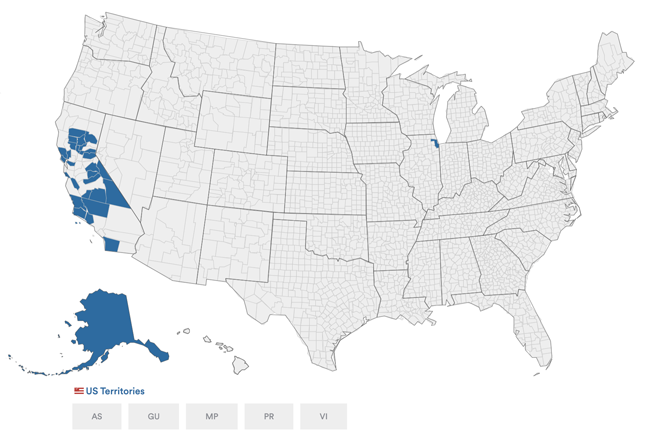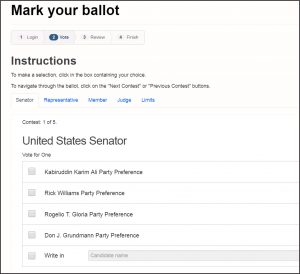
Dominion Voting Systems
ImageCast Remote
Make / Model: Dominion ImageCast Remote
Equipment Type: Remote Ballot Marking System
Back to Voting Equipment Database
Overview

Dominion’s ImageCast Remote is a client-side remote ballot marking system. The system has been used in elections since 2006 and is part of Democracy Suite, Dominion’s Election Management System. The ImageCast Remote software platform utilizes N-Tier (or multitier) software architecture.
The system supports WCAG 2.0 Level AA conformance, multiple languages, browser-based screen readers and Audio-Tactile Interfaces (ATI). The ImageCast Remote uses standard HTML and JavaScript and is compatible with Microsoft Explorer, Firefox, Safari, and Chrome.
Voters can use the system on their personal computer, tablet, smartphone, or touchtone phone. After the voter has marked their ballot, the system generates a PDF of an “Electronic Mobile Ballot,” which is a representation of the voter’s summary ballot, containing a human readable summary of the voter’s selections and a 2D QR code, which is not human readable and allows the ballot to be scanned by a Dominion ImageCast ballot scanner instead of being remade onto traditional ballot paper by hand or with a ballot duplication system. The Electronic Mobile Ballot can have more than one QR code, containing the number of available contests, candidates, and write-in candidates.
Voting Process
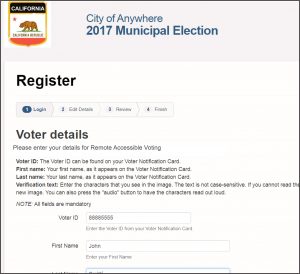
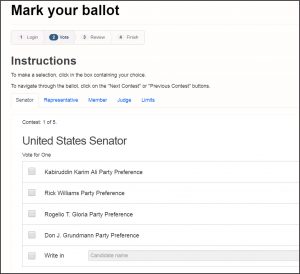
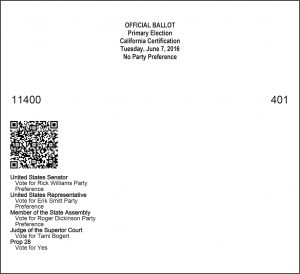
To mark a ballot using Dominion’s ImageCast Remote, a voter first must submit a request for an electronic ballot to their elections administrator. Upon approval, the voter is provided a login ID and PIN to access the ImageCast Remote system via their preferred method of contact (e.g. email or postal mail).
A voter accesses the ImageCast Remote on their preferred device and in their preferred browser. The voter must authenticate themselves using their login ID and PIN, as well as their first and last name. The voter must also complete a “Human Interface Challenge” (CAPTCHA) by entering the characters they see or hear on the screen. The voter is then presented their particular ballot style and selects their preferred language from the list of available languages.
The voter makes their selections by selecting the box to the left of the candidate of their choice. To write in a candidate, the voter selects the “Write in” box and then fills out the text box. The voter will receive instructions to vote for one or more candidates in each contest.
Voters using screen readers or other assistive devices are instructed how to mark the ballot and navigate through the system. Voters also receive status updates about how many selections remain in a contest.
After the voter has navigated through all of the contests on the ballot, they may review their selections on the review screen. Here, the voter receives any overvote or undervote warnings and may return to previous screens to modify their selections.
If the voter is satisfied, they download their ballot as a PDF. The ballot is an “Electronic Mobile Ballot,” which is a summary of the voter’s choices, meaning the voter sees only their selections — not all of the candidates in each contest. The summary ballot also contains the election, date, voter’s preferred political party, and ballot style. The voter may then end their voting session.
The ImageCast Remote does not support the electronic return of voted ballots (internet voting). Depending on the jurisdiction, email or fax return may be allowed, or mail or drop off return may be required. To return a ballot via postal mail or drop off, the voter prints their PDF and downloads their ballot package, which contains a cover sheet showing the name and location of the jurisdiction in which the election is taking place, information regarding the election itself, and instructions for the voter about the completion and return of the ballot; the voter affidavit, which is to be read and consented to by the voter, and then returned with the ballot; and a printable template to create a return envelope.
References
Resources
Democracy Suite RAVBM Version 5.10 Use Procedures (2020)
California: Conditional Approval for Dominion Voting Systems ImageCast Remote 5.10 (2020)
Colorado: Democracy Suite Version 5.11 System Overview
California: Dominion Democracy Suite 5.10 Staff Report (2019)
Dominion ImageCast Remote Version 5.10 Remote Accessible Vote by Mail System Staff Report (2019)
Dominion Democracy Suite ImageCast Remote 5.10 RAVBMS Accessibility, Usability and Privacy Test Report (2019)
Dominion Democracy Suite ImageCast Remote 5.10 RAVBMS Staff Report (2019)
Dominion Democracy Suite ImageCast Remote 5.10 RAVBMS Software Test Report (2019)
Dominion Democracy Suite ImageCast Remote 5.10 RAVBMS Security and Telecommunications Report (2019)
Public Hearing: Dominion Voting Systems Imagecast Remote 5.2 Remote Accessible Vote by Mail System (2018)
Dominion ImageCast Remote Brochure
Security Concerns
Unreadable Bar Codes and QR Codes
Bar codes and QR codes are not readable by humans and, as Michael A. Specter and J. Alex Halderman point out in their Security Analysis of the Democracy Live Online Voting System — not Dominion’s ImageCast Remote system — an attacker could encode false votes within a bar code without the knowledge of the voter. The ballot summary could properly display the voter’s selections in the human-readable section, but contain the hacker’s choices in the QR code, which the voter cannot read.
According to California’s Dominion Voting Systems Democracy Suite 5.10 Staff Report, created by the California Secretary of State’s Office of Voting Systems Technology Assessment in 2019, the QR codes are encrypted and there is thus no way to verify the selections contained within it without scanning it on an ImageCast scanner. The Office of Voting Systems Technology Assessment tested the ImageCast Remote, generating 25 summary ballots, which were duplicated on a Dominion ImageCast X and by hand, and then scanned on all Dominion scanners to verify compatibility. The Office of Voting Systems Technology Assessment was unable to verify that the selections within the QR code matched the selections on the human readable portion of the summary ballot without scanning the summary ballots on an ImageCast device. Upon tabulating the ballots, the Office of Voting Systems Technology Assessment found they scanned as expected.
Manufacturer Profile
Dominion Voting Solutions was founded in 2002 in Toronto, Canada by John Poulos and James Hoover. Dominion Voting Systems purchased Premier Election Solutions from Election Systems and Software in May, 2010 and Sequoia Voting Systems in June, 2010. After these acquisitions the company relocated to Denver. Sequoia and Premier voting equipment is found under the original manufacturer.
